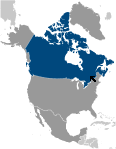World Atlas: Canada. On this page you can see the map, country flag and many detailed information about the people, history and economy of Canada.

Here you can find online selected information about the geography, inhabitants, government, economy and history of Canada. Included are selected statistics, an overview map and the detailed map of Canada. But let's start with the flag of Canada here:
Canada - Overview:
What you should know about Canada? Let's start with this: A land of vast distances and rich natural resources, Canada became a self-governing dominion in 1867, while retaining ties to the British crown. Canada repatriated its constitution from the UK in 1982, severing a final colonial tie. Economically and technologically, the nation has developed in parallel with the US, its neighbor to the south across the world's longest international border. Canada faces the political challenges of meeting public demands for quality improvements in health care, education, social services, and economic competitiveness, as well as responding to the particular concerns of predominantly francophone Quebec. Canada also aims to develop its diverse energy resources while maintaining its commitment to the environment.
Geography of Canada
 Where on the globe is Canada? The location of this country is Northern North America, bordering the North Atlantic Ocean on the east, North Pacific Ocean on the west, and the Arctic Ocean on the north, north of the conterminous US. Total area of Canada is 9,984,670 sq km, of which 9,093,507 sq km is land. This is one of the largest countries in the World. How could we describe the terrain of the country? This way: mostly plains with mountains in west, lowlands in southeast. The lowest point of Canada is Atlantic Ocean 0 m, the highest point Mount Logan 5,959 m. And the climate is varies from temperate in south to subarctic and arctic in north.
Where on the globe is Canada? The location of this country is Northern North America, bordering the North Atlantic Ocean on the east, North Pacific Ocean on the west, and the Arctic Ocean on the north, north of the conterminous US. Total area of Canada is 9,984,670 sq km, of which 9,093,507 sq km is land. This is one of the largest countries in the World. How could we describe the terrain of the country? This way: mostly plains with mountains in west, lowlands in southeast. The lowest point of Canada is Atlantic Ocean 0 m, the highest point Mount Logan 5,959 m. And the climate is varies from temperate in south to subarctic and arctic in north.
Inhabitants of Canada
Let's take a look how many people live in Canada. The number is: 35,623,680 (July 2017 est.). So quite a lot people live here. Who lives here? Canadian 32.2%, English 19.8%, French 15.5%, Scottish 14.4%, Irish 13.8%, German 9.8%, Italian 4.5%, Chinese 4.5%, North American Indian 4.2%, other 50.9%. What are the languages in Canada? English (official) 58.7%, French (official) 22%, Punjabi 1.4%, Italian 1.3%, Spanish 1.3%, German 1.3%, Cantonese 1.2%, Tagalog 1.2%, Arabic 1.1%, other 10.5% (2011 est.). And the religions: Catholic 39% (includes Roman Catholic 38.8%, other Catholic .2%), Protestant 20.3% (includes United Church 6.1%, Anglican 5%, Baptist 1.9%, Lutheran 1.5%, Pentecostal 1.5%, Presbyterian 1.4%, other Protestant 2.9%), Orthodox 1.6%, other Christian 6.3%, Muslim 3.2%, Hindu 1.5%, Sikh 1.4%, Buddhist 1.1%, Jewish 1%, other 0.6%, none 23.9% (2011 est.). How old are the people in average? 42.2 years. We have to add that this number is the median - so one half of the people is older than this, one half is younger. And what is their life expectancy (at birth)? This: 81.9 years. Where the people live in Canada? Here: vast majority of Canadians are positioned in a discontinuous band within approximately 300 km of the southern border with the United States; the most populated province is Ontario, followed by Quebec and British Columbia. The major urban areas of Canada are: Toronto 5.993 million; Montreal 3.981 million; Vancouver 2.485 million; Calgary 1.337 million; Ottawa (capital) 1.326 million; Edmonton 1.272 million (2015).
Government and Economy of Canada
The capital of Canada is Ottawa and the government type federal parliamentary democracy (Parliament of Canada) under a constitutional monarchy; a Commonwealth realm. Let's take a look at the administrative divisions - 10 provinces and 3 territories; Alberta, British Columbia, Manitoba, New Brunswick, Newfoundland and Labrador, Northwest Territories, Nova Scotia, Nunavut, Ontario, Prince Edward Island, Quebec, Saskatchewan, Yukon. Regarding the economy of Canada, important industrial products are transportation equipment, chemicals, processed and unprocessed minerals, food products, wood and paper products, fish products, petroleum, natural gas. Important agricultural products are wheat, barley, oilseed, tobacco, fruits, vegetables; dairy products; fish; forest products. The most important export commodities are motor vehicles and parts, industrial machinery, aircraft, telecommunications equipment; chemicals, plastics, fertilizers; wood pulp, timber, crude petroleum, natural gas, electricity, aluminum and the most important export partners are US 76.4%, China 4.1% (2016). The most important import commodities are machinery and equipment, motor vehicles and parts, crude oil, chemicals, electricity, durable consumer goods and the most important import partners are US 52.2%, China 12.1%, Mexico 6.2% (2016). How rich is Canada and how rich are people in this country? The most important number here is GDP per capita (PPP): $48,100 (2017 est.). This means the people are rich on average here. Let's add that this means Gross Domestic Product per person, which is recalculated with respect to the relative cost of local goods and services. And one more important number - population below poverty line: 9.4%.